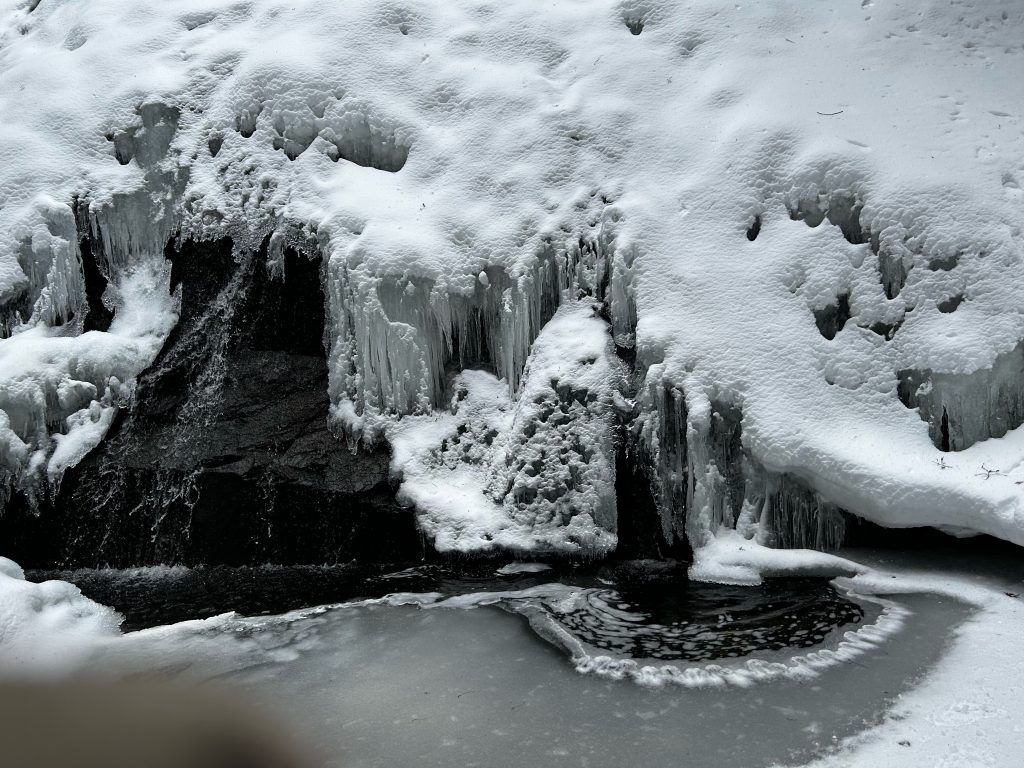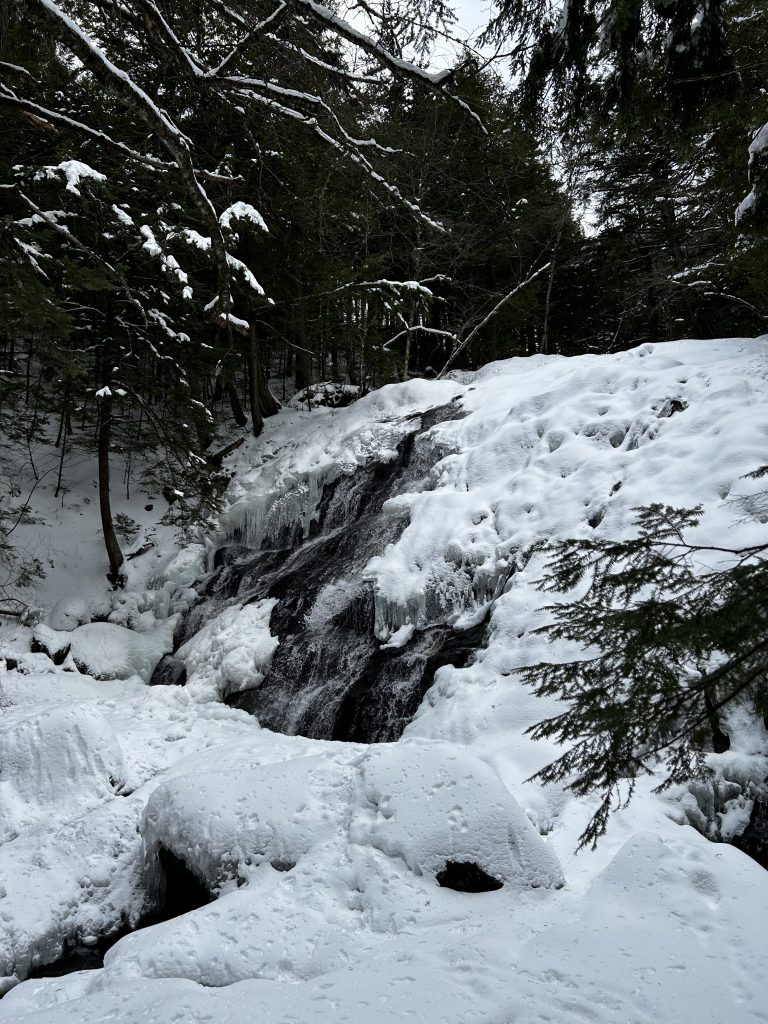
Waterfalls fascinate me. I am fortunate to have seen some of the better-known big falls in America – Niagara, Yellowstone, and Lava Falls in the Great Canyon, for example – and am moved by their thundering power, the great spray and foam they fling into the air, the roiling of muscular current. But I am quite taken by the show that much smaller waterfalls put on – falls of a size where I may draw close to the water’s edge, behold swirling patterns in the drop pools at the bottom of the falls, feel cool mist on my face and hands. We have a good many of these smaller, more approachable, waterfalls in our Western Mountains of Maine, falls that I enjoy making a hiking destination – in winter as in summer.
Among these hike-to falls are Angel Falls, Poplar Stream Falls, West Mountain Brook Falls, Cascade Gorge cascades, and Reed Brook Falls. Small Falls is probably the best-known set of waterfalls in the region, but as a hike it is quite short – perhaps a 0.2 mile round trip, at the most, from Maine Highway 4, south of Rangeley. Other short-stroll falls are those on Cascade Brook in Farmington; Mosher Hill Cascades, also in Farmington; Shadagee Falls and Sarampus Falls on the North Branch of the Dead River, in Jim Pond and Alder Stream Townships, respectively.
One of my favorites is Reed Brook Falls in Kingfield, reached by a 0.6 mile hiking trail (1.2 miles round trip), with a trailhead on Highway 27. I estimate the drop to be nearly 40 feet, over and down an abrupt rock face 30 feet wide. Locals know of these dramatic falls, and how to reach them on foot. But for years, with no roadside sign to mark a trailhead and little or no publicity, few people had any idea that these falls exist. That situation has changed, as there is now a fairly new trail in place, that leads from a signed parking area, and is straightforward to follow.

Expecting Reed Brook Falls to be putting on a bit of a show at mid-winter, I grab my snowshoes and a set of trekking poles with snow baskets, pack my day pack with standard winter essentials, and head for Kingfield. The trailhead parking area is immediately to the left of the entrance to Carrabassett Veterinary Services at 1082 Main Street, north of downtown Kingfield. This entrance is also signed as Barred Hill Road, but there is no missing the prominent sign for the clinic.
The trailhead sign is entertaining in itself, delightfully hand painted and decorated by someone who goes by the name “Carrabassett Jack”. The trail is on private property, and carries certain conditions: no bikes, no camping, and no music – presumably meaning no recorded music. I expect that if I wanted to bring my harmonica along, and play as I sit by the brook making my own music, that would be okay. Lately I have been surprised to meet people on hiking and cross-country ski trails who are playing music aloud from a device (no personal earbuds) as they hike or ski. That is considered contrary to backcountry manners, as so many hikers are on the listen for the calls of birds, the sound of the wind, creaking of wind-rocked trees in winter, and the rush of quick water.
The trail heads southwest, following a blue-painted property boundary for 0.2 miles to reach the north bank of Reed Brook. A 2” layer of fresh powder lies on a track packed by previous parties on snowshoes. I could dispense with my snowshoes, and hike with only the winter hiking boots I am wearing, but I know the snow on either side of the track to be crusty on top, and of uncertain depth underneath. If I want to explore off-trail – or if those hikers before me by a day or two did not reach the falls – I will be glad to have my snowshoes.

The day is a mix of clouds and sun – more of the former. A stiff wind blows down the valley of the Carrabassett River, and reaches well into the wooded foothills where Reed Brook flows. It is chilly. I pull out a neck gaiter, and wool liner gloves to place inside my winter mitts. To block the wind and retain body warmth I wear a breathable wind and rain blocking shell jacket with a hood, with a fleece layer under that. In my pack I carry a down jacket to put on if I decide to hang out by the falls for a time, and a square of closed cell foam that I saved from a package delivery in case I want to sit on a snow draped boulder or log.
On trail, I drop down into a side draw and pass a step-over small stream. Next, I cross and recross a twitch trail from a logging operation of not too many years ago, as I head for the brook, still out of sight. A mix of young rock maple, beech, and white birch, and a few fir, stand trailside. When the cloud cover fully hides the sun, the landscape takes on the aura of a sharp black and white photograph – curious and intriguing. The beech, with their amber, parchment-like leaves hanging tight, offer bright contrast to the grays and dark greens of the other trees of these woods.
Away from the road and the highway sounds, I enter a realm of the sound of – well, no sound. Not exactly, of course, because the rise and fall of the wind make a certain music,
and I catch the chattering of a red squirrel somewhere just out of sight. Perhaps the squirrel is announcing to the other creatures of the woods that there is a sizeable being moving through the forest, i.e., me. The deep quiet brings my attention to the light pad and soft creak of my footfalls on the snow, and the give and take of my own breathing. The spareness of winter prompts me to notice much that I might miss at high summer when the woods are full of the calls of birds, and the wind blows through the mass of well-leafed out hardwoods, those leaves a-flutter.
The blue boundary markers lead to the edge of Reed Brook. Slabs of snow-blanketed ice lie where there is quiet water beneath. Here and there runs dark, open water, punctuated by boulders. Oh, the rush and muffled roar! I do love that sound, and there is more of that to come. The trail to the falls turns to the right, more decidedly west, to follow the ridge of high ground that rises just above the north bank of the brook.

The forest here is of serene and majestic, with high hemlock, great balsam fir, and thick white cedar. The hemlock gets my attention. I stop at the base of one these ancients that must be three feet in diameter. For perspective I take a rough measure using a trekking pole. Three feet it is. Snow-covered landscape, old forest, the busy world out of sight and out of mind – this is one remarkable spot.
A sign greets me, offering a choice. Bear left to clamber a boulder route immediately streamside, and perhaps in summer, a rock-step route up the brook itself. Move to the right for the winter route, which the sign warns may be icy. My snowshoes have built-in metal crampons, which serve well on moderate slopes. I choose the winter option, which keeps the brook well in view. What I am avoiding by not taking the boulder route is the risk of stepping onto insecure shell ice under snow between the boulders.
Below me, here and there, full length trees lie across the brook, hung up on boulders. Surely these were swept down the brook at spring run-off when the water is high and the current unrelenting, What a sight that must be when the high peaks and foothills give up their snow cover, and Reed Brook fills bank to bank – or higher.
On I trek, glancing now and then upstream to gain a glimpse of the falls. I know the brook makes a turn at the foot of the falls, which places the big drop and all the water action just out of sight for the approaching hiker, until an “oh-my-gosh” moment. Those who drive Highway 27 northward towards Sugarloaf know of “oh-my-gosh” corner when the view opens up to reveal rather suddenly the broad sweep of the north face of that impressive peak. Reed Brook has its own such moment.
I hear the thunder of the falls before I see them – a deep beat, pulsing. A few feet more, a swing around the last turn of the brook complete, and there they are. An all but totally frozen waterfall. Such a sight. I step closer, mindful not to step onto unstable ice, until I am but a short rock toss from the base of the falls. A great shell of ice has formed on the falls, with water roaring behind it to drop into the pool below. A mix of rain and snow, and a cycle of freezing, thawing, and refreezing, has resulted in the formation of this curiously sculptured shell. A curiosity to look upon, the shell is all the more captivating because it creates a sound chamber for the water that tumbles and rumbles down the rock face behind it.

At the very base of the falls, where falling waters dump into the streambed, a pool of dark water pulses with wave after wave. Some of those waves shoot downstream as though suddenly free to roam new territory on the run toward the sea. Other waves ripple out to nearby shelves of ice, slip beneath them, slap them from underneath. These sounds echo in the bowl formed by centuries of rock-cutting waters flowing this course. Quite the show. I look, and I listen, for a good while.
A chill. I am not generating much heat standing still in winter. I don my down jacket, sit on a rock insulating myself from the snow with that foam pad I carry. Time to break out some hot tea from an insulated water bottle, and down a granola muffin I baked the night before. One way to generate heat in winter is to move. Another is to put some fuel in the tank. I fuel up, pack up, start the return hike.
The hike out is essentially downhill. I pass through the high hemlocks, peering upward in case a porcupine is feeding well above. Porkies favor the tender tips of hemlock branches, and will climb to precipitous heights to get at them. No porcupines today. Suddenly, as though someone yanked back a curtain, the clouds part. Sun on the snow! A patch of blue sky! Just as quickly, clouds return, and it is a monochrome world again – only to switch back and forth for much of my hike out to the trailhead.
The hike to Reed’s Brook Falls is short. Therein lies a good bit of the attraction. When trail distances are short, there is ample time to discover much that otherwise I might hurry by – the echo of rippling waves slapping the underneath of shell ice, the bright color of beech leaves, or the chattering of a red squirrel.

I hope to see you on trail.
______________________________________________
Text and photos copyright Douglas Allan Dunlap 2023




